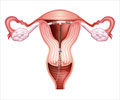A systematic review of studies has revealed that surgery is a more effective effective option than oral or intrauterine medication for women experiencing heavy periods in reducing volume of bleeding at one year.
However, on subjective measures of effectiveness — satisfaction and improved quality of life — a hormone-releasing intrauterine device (IUD) is as effective as surgery, the review found.“Satisfaction with treatment is probably more meaningful than estimates of blood loss. While conservative surgery reduced blood loss more than the IUD, the two treatments appeared about equal in terms of patient satisfaction,” said review co-author Jane Marjoribanks, at the University of Auckland in New Zealand.
The review appears in the current issue of The Cochrane Library, a publication of The Cochrane Collaboration, an international organization that evaluates research in all aspects of health care. Systematic reviews draw evidence-based conclusions about medical practice after considering both the content and quality of existing trials on a topic.
The reviewers identified eight randomized controlled trials that compared either hysterectomy or conservative surgery with medical therapy using either oral drugs or the hormone-releasing IUD. The studies enrolled a total of 821 women.
Heavy menstrual bleeding affects about one in five women of reproductive age and is the most common cause of anemia in premenopausal women. Medical treatments include oral drugs and a hormone-releasing IUD to decrease blood loss. Surgical options range from conservative procedures that destroy the lining of the uterus to hysterectomy, which removes the uterus entirely. While hysterectomy is the only treatment that is completely effective, it also carries the highest risk.
In the two studies that compared surgery and oral medications, surgery was more effective in controlling bleeding and other symptoms and improving women’s quality of life at four to six months. In these trials, women who were not satisfied with their results were allowed to change treatments, and by the two-year follow-up, 58 percent of women randomized to oral drugs had elected to have surgery. At that point, differences in quality of life and symptoms were no longer significant.
Advertisement
Health-related quality of life and satisfaction rates were also equivalent in the single head-to-head comparison between hysterectomy and the IUD. In that study, 58 percent of women randomized to receive the IUD were able to avoid hysterectomy. Moreover, the costs associated with the IUD were about 40 percent lower than for hysterectomy after five years of follow-up.
Advertisement
“However, this does not mean that one should not try these treatments,” Duleba said. “As effectiveness increases, invasiveness increases. For some patients, the best treatment is going to be medical, and those patients can avoid the risks of surgery.”
In the United States, oral drugs for heavy menstrual bleeding include birth control pills, progesterone analogs and nonsteroidal anti-inflammatory drugs. The IUD that was evaluated in six of the eight trials in this review — the levonorgestrel intrauterine system, or LNG-IUS — has been in use in Europe for more than a decade and was approved by the U.S. Food and Drug Administration in 2000.
Hysterectomy has been considered the definitive treatment for heavy menstrual bleeding, since removal of the uterus brings an end to menstruation. Of the approximately 600,000 hysterectomies performed in the United States each year, about 20 percent to 30 percent are done to treat excessive uterine bleeding. However, hysterectomy isn’t an option for women who plan to have children, and its greater success in resolving heavy menstrual bleeding is also associated with greater risk.
The reviewers noted that “adverse effects of hysterectomy were relatively common and potentially life-threatening” in the two trials that included hysterectomy, and there were 39 complications among the 131 women who had a hysterectomy.
In the 1980s, conservative surgical alternatives to hysterectomy became available that remove or destroy the lining of the uterus using an electric loop, laser, hot water balloon, ultrasound or other device. These procedures have fewer risks of serious complications and can often be done on an outpatient basis.
“I think we are very lucky that we have a huge range of options,” said Duleba. “Physicians should be aware of these options and review them with patients in a stepwise fashion of degree of aggressiveness because the patient’s attitude, tolerance of risk and desire for a permanent solution are all significant factors.”







